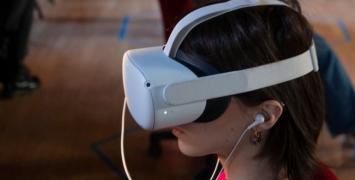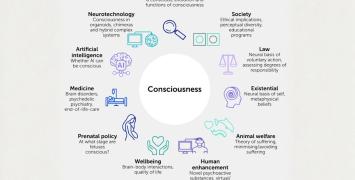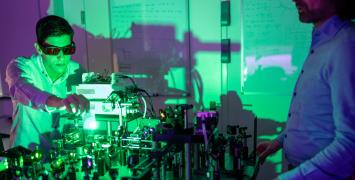How beetles decode nature’s signals

By Inge Ruigrok -
Dung beetles are notable not only for their ecological role in recycling animal waste but also for their extraordinary navigation skills. They rely on signals from the sky, such as the sun, moon, and stars, to guide them. By observing these natural cues, dung beetles can move in a straight line, which is crucial for efficiently transporting their dung balls away from the fierce competition for food at the dung pile.
Marie Dacke, a Professor of Sensory Biology at Lund University, has been studying this navigation system for over two decades. ‘Initially, we identified many different cues these animals use to navigate, like the sun, the moon, polarised light patterns, and the Milky Way’, she says. ‘Our more recent research demonstrate that beetles can also use the wind to steer straight. This raises an interesting question: how do they combine all these directional cues? Do they simply add them together, average them, or rely on different ones depending on the situation?’
‘At first, we assumed they would simply rely on the directional information from one cue at the time, but further experiments showed that wasn’t the case. These findings sparked a deeper interest in understanding the principles animals use to integrate information from various sources.’
Ideal model
Dacke and her team are using biology, bioinformatics, and mathematics to study the brain activity of dung beetles while they navigate. A key tool that is being developed is a small electronic device attached to the beetle’s back. ‘Their relatively large size makes dung beetles an ideal model for this type of research’, Dacke explains. ‘They are strong enough to carry small electronic devices during navigation, allowing us to collect data in ways that would be impossible with smaller insects. While devices for electrophysiology already existed, they required significant adaptations to obtain a good signal from the insect’s brain. First, we need to access the brain, locate the correct area, and ensure it remains intact.’
‘A few weeks ago, we recorded data from a freely walking beetle for the first time’, Dacke comments on this major milestone. ‘It has taken us four years to get to this point. We've come a long way and learned a lot. It’s has been a steady progression and steep learning curve in what we can achieve with these animals. Our ultimate goal is to gather real-time recordings while they move in their natural environment so we can begin to understand how they adjust their behavioural strategies based on their surroundings. I’m hoping we can take steps towards that goal in the coming year.’
Beetle neurons
Directly recording the activity of beetle neurons is one way to understand how the networks of nerve cells in their brains change based on different situations. ‘We also do a lot of behavioural studies to see how these networks process information,’ Dacke explains. ‘For example, if we move the sun 180 degrees across the sky and the beetle turns around by the same amount, it shows that the beetle is using the sun for navigation. From this type of studies, we’ve learned that beetles can adaptively weigh different sources of information based on how reliable they are. It’s not a fixed system where they treat all cues the same.’
‘For instance, if the wind is blowing and the sun is at a 45-degree angle, the beetle will seemingly ignore the wind because the sun gives more reliable information. We also found that when the sun is very high in the sky, it’s harder for the beetle to use it for direction because it doesn’t provide any guidance. In those cases, the beetle relies more on the wind. This system is very flexible, both within individual beetles and in different habitats. The rules change depending on their current sensory environment they are.’
Adaptable brain
Her current project is called the ‘ultimate compass’ and for good reason. It encapsulates the extraordinary ability of these beetles to navigate. ‘It's really cool to see how flexible the beetles are in adjusting what they rely on. For example, if one cue is twice as reliable as another, the beetle will prioritise that more reliable cue. People often think of an insect’s brain as a fixed system, but it’s incredibly adaptable. It’s more refined than we might think.’
‘The animals we use as a model can navigate in extremely dark conditions, under a starlit sky, but they can also orient themselves in bright environments. They can even navigate in urban areas, despite the effect of light pollution on their compasses. The term 'ultimate' refers to the fact that their navigation system works in nearly any environment on Earth, except for complete pitch darkness—which is a very artificial condition. In all natural environments, they perform remarkably well. What makes their compass 'ultimate' is its versatility: they can seamlessly move between different environments, and if, for example, the sun disappears behind a cloud, it doesn’t affect their orientation.’
Dacke and her team are also using AI to enhance their findings. By collaborating with roboticists, they can create a circuit based on these principles and implement it in a robot. When the robot is placed in the field alongside the beetle, if they have correctly understood the beetle’s behaviour, the robot should act similarly. Dacke: ´If it doesn't, then we know we’ve missed something. This process helps us pinpoint where the model breaks down, as we can compare the robot’s actions with the beetle’s behaviour. It’s a cycle that moves between studying the animal and the machine. And that leads to a next question: how do they decide what’s more reliable? That’s what we will continue to explore in future projects.’
Honeybees
By understanding how these navigational systems work, we can help protect specific regions of the world for animals and understand the reasons behind certain environmental phenomena’, Dacke says about the expected impact of her findings. ‘We suspect that similar navigational systems might exist in other insects beyond the dung beetle. From an evolutionary perspective, we expect many of the navigation circuits to be conserved across species. Therefore, by studying how the dung beetle navigates, we might also gain insights into why honeybees sometimes fail to return to their hives—it's all connected.’
Another important aspect is navigation itself. ‘We're learning about navigation systems that don’t rely on man-made inventions,’ Dacke explains. ‘While satellite systems are effective when operational, this research explores a different type of navigation that works in all environments across the globe. From a technical standpoint, we aim to understand how animals, particularly insects with tiny eyes, solve complex problems. Despite receiving minimal information, they can extract details from faint, distant sources, such as stars. This relates to signal processing in miniature systems, which has broader applications. Consider how small cameras in devices like iPhones struggle to capture detailed information but still manage to do so. We’re investigating similar challenges in these natural systems, and that's another exciting aspect of our research.’
Biography
Marie Ann-Charlotte Dacke is a Professor of Sensory Biology at the Lund Vision Group, Lund University, in Sweden. Her research focuses on both nocturnal and diurnal compass systems, with the dung beetle serving as her model organism. In 2025, Dacke became a Wallenberg Scholar, and in 2022, she was elected as a fellow of the Royal Swedish Academy of Sciences. Dacke is also passionate about public science education and serves as a panel member on the Swedish TV show Studio Natur. In 2013, she was awarded the Ig Nobel Prize for her research on the navigation systems of dung beetles. Additionally, since 2018, she has been an honorary professor at the University of the Witwatersrand in Johannesburg, South Africa. In 2012, Dacke was recognised as Sweden's best science communicator by winning the national Forskar Grand Prix (Science Grand Prix).






